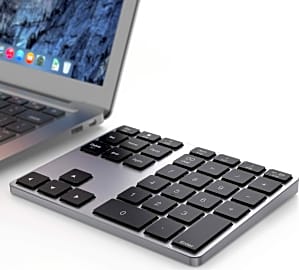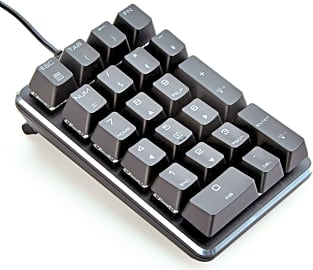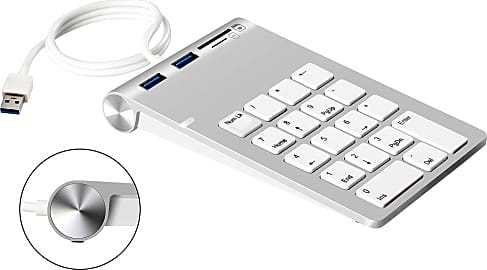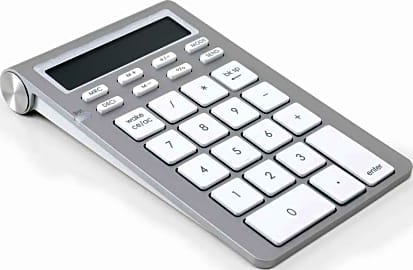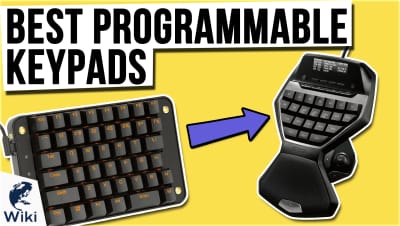The 10 Best Numeric Keypads

This wiki has been updated 45 times since it was first published in October of 2015. Whether you're frustrated trying to use the digits on the top row of your laptop's keyboard or you want to use your tablet to do some heavy-duty number crunching, one of these numeric keypads may be the answer. They come in wired and wireless versions and can make any repetitive task a whole lot easier, including bookkeeping, data entry, and working with spreadsheets. When users buy our independently chosen editorial choices, we may earn commissions to help fund the Wiki.
Editor's Notes
January 15, 2021:
Since not everyone uses their number pad for the same kinds of applications, we made sure to include a variety of models well suited to different uses. For example, those who are used to premium keyboards with mechanical switches will probably find the Perixx PeriPad 303B, Motospeed MSK24, and Qisan Magicforce feel the best to them. All of these also feature backlighting, however the MSK24 is the only one that offers RGB illumination, which will probably appeal to gamers. Unfortunately, all of these models are wired, so those that prefer something wireless will have to look elsewhere, such as to the Jelly Comb N030 and Jelly Comb N042, which connect using a USB dongle, or the Satechi WKP31, LevKey 6257,BonBonbrothers Wireless, and Joyeky Bluetooth, all of which have Bluetooth. These last two models offer a 35-key layout for those that need a lot functionality from their number pads. Both the Cateck Combo and Satechi WKP31 stand apart from all the rest, the former because of integrated USB and card slots, and the latter because of its 12-digit LCD and the ability to function as a standalone calculator.
December 27, 2019:
For some tasks, the home number row just won't cut it, and not all keyboards come with a built-in number pad. Of course, most people get by with simple, membrane keyboards, which the Jelly Comb N001 and Seenda Slim both emulate. As such, they're quite affordable, although they may feel sluggish and mushy if you're used to using a high-end keyboard. The Rottay Numpad should, actually, satisfy users of advanced keyboards, although not everyone prefers the loud noises its blue switches make. Alternately, the Qisan Magicforce is made with much quieter Gateron Browns, as is the Perixx PeriPad 303B.
Those constitute the compact, wired models, and there are a handful of larger and more accessible models, as well as some great wireless ones. The LevKey Number Pad has a convenient function row on its left side and the Joyeky Wireless has a relatively complete set of useful buttons, although both of those lose some functionality when connected to a Mac. The Cateck Combo isn't exactly compact, and it is USB only, but it does have three USB ports built right in, so not only will it not take up your only USB port, you'll also be able to use additional devices in line with it. The iOne Scorpius is relatively large and built like a tank, and if you're looking for an easily positioned option when programming, it's an excellent choice. And if you do a lot of account figuring in addition to number entry, check out the Satechi WKP31, which features a standalone calculator function that doesn't even require the computer to be on in order to use.
Wired Vs Wireless; Does It Make A Difference?
Interference form other 2.4ghz devices is possible as well, which leads many to stick to wired options.
With the modern era have come benchmarks in convenience such as wireless connection. Yet, not every user is a fan of the idea. Does it make a difference in the functioning of the end product, or is it a matter of personal preference?
Wireless connection works in a similar manner in all devices. Whether it be a remote-controlled car, wireless house phone, or numerical keypad; wireless connection works through radio frequency, or RF technology.
The RF technology process requires two basic components: a receiver and a transmitter. In the case of a numeric keypad, the transmitter is in the keypad itself. It sends out an electromagnetic signal which includes information about the keys pressed on the keypad. The receiver is generally plugged into the computer. This receiver accepts the signal and turns it into information the computer's operating system can use. Using radio frequencies means the signal can pass through barriers on its way to the receiver. Books, desks, monitors, and relatively large distances can be traversed by the signal with ease.
On the other hand, wireless keypads require pairing and encryption to be secure. As many household items operate within the 2.4ghz frequency band, there is room for attackers to hack this frequency and steal any information passed through it. This is one reason many transmitters and receivers encrypt information sent through radio waves. Interference form other 2.4ghz devices is possible as well, which leads many to stick to wired options.
Some people prefer not to have too many wires and cables in their work space, while others perceive wired units to be faster. This may be superstition, however. The difference in speed is undetectable.
Others note possible health implications from being surrounded by radio frequencies. While using one radio-controlled device may have little to no effect on the human body, some users are wary of the lack of long term studies on the health effects caused by increased exposure to radio frequencies in the modern era. A branch of the World Health Organization classified radio frequency as a possible carcinogen to humans, but said there remains no definitive evidence towards this. One study showed that radiation from 2.4ghz devices can affect the nervous system when turned up; implying that over time this may have an adverse effect on humans. Concerned users aiming to reduce their interaction with radio frequency fields usually stick to wired devices wherever possible.
Who Uses Numeric Keypads?
As the modern era has brought about the race to smaller, more portable devices; seemingly extra external features have regularly become after-market options. While standard keyboards regularly include a numerical keypad, it became common to remove them from laptops. Many external keyboards have even removed the numeric keypad feature.
Data entry positions regularly require workers to input large amounts of information, including numbers.
Numeric keypads are a must-have for anyone who regularly inputs a lot of numbers into a computer. Data entry positions regularly require workers to input large amounts of information, including numbers. This is difficult with the row of numbers provided above the standard QWERTY keyboard. Just as there are alternative options to keyboard layouts, the numeric keypad provides a much better option to entering numerical data. The physical reason for this is that the amount of hand movement required to enter numbers using the top line on a keyboard is very impractical. From the key for the number 1 on a keyboard, reaching the key for the number 9 requires unnecessary stretching or hand movement to perform. The standard numeric keypad is about the size of a palm, and the hand can stay centered over the entire area of input at once.
Networking and systems administration positions will likely need to use a numeric calculator. Entering multiple IP addresses all day can become tiresome without the use of a proper keypad.
Mathematicians and accountants also favor the numeric keypad for its calculator-like layout. When a lot of basic algebra needs to be executed quickly, the keypad is the place to go. Most keypads have additional keys for the most commonly used functions of a calculator. Keys for addition, subtraction, multiplication, and division are standard in most keypads. This can all be accomplished with relative ease and as little hand movement as possible, making it a very efficient process.
Evolution Of The Numeric Keypad
The numeric keypad's introduction into modern computing is a blend of two devices' historical stories: the keyboard and calculator.
The keyboard has its roots in typing, and specifically, the typewriter. The typewriter is said to have been invented as early as the year 1714, when Henry Mill filed a patent for a typing machine which typed one letter after the other, as in hand writing. The first known working machine was created in 1808 for a blind woman to write with.
This feature made them more valuable to offices which required calculation.
As the standard typewriter took the market in 1874, the QWERTY keyboard came with it. This is the standard keyboard we have to this day, and its creators focused less on efficiency as they did on keeping the keys from jamming. In other typewriters of the time, when typists became proficient, they were too fast for the keys. This led to jams and stuck keys. The QWERTY keyboard was introduced to prevent that, and has since become the standard for all keyboards. Other efficient ways of typing exist, such as the Dvorak keyboard, but are simply not familiar to the hands and therefore not popular.
When the computer was introduced, the QWERTY keyboard stayed and very quickly the numeric keypad was introduced. This was due to the early need for calculations in computers. When the computer keyboard was introduced, solving non-linear equations with a calculator was becoming easier than ever. Basic calculator programs were often added to early computers as a selling point. This feature made them more valuable to offices which required calculation. To better support this feature, the numeric keypad from accounting calculators was added onto the QWERTY keyboard of the day, and the full keyboard as we know it today came to be.




